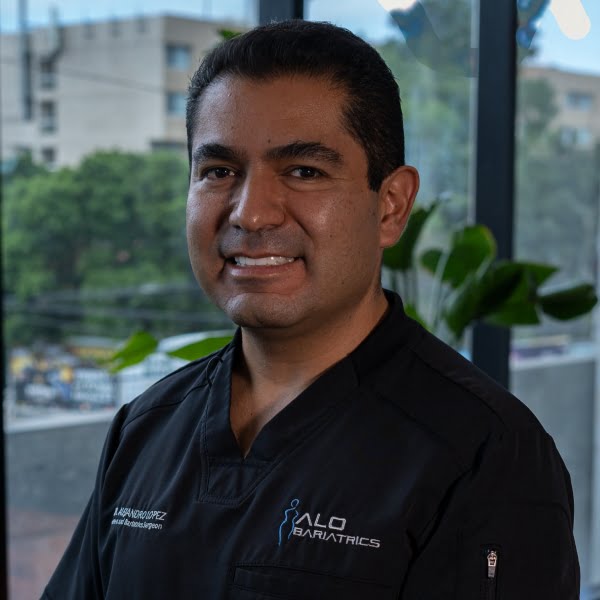SADi-S vs Duodenal Switch: What’s the Difference?
Progress in bariatric surgery gives our patients more choices when picking the right weight loss surgery. The surgeons at ALO Bariatrics have become proficient in many modern techniques. Two common and effective options are the single-anastomosis duodenal-ileal bypass with sleeve gastrectomy (SADI-S) and the biliopancreatic diversion with duodenal switch (BPD/DS) procedures. These terms may seem confusing, but we’ll simplify and explain the differences and similarities between these two procedures below.
Read on to better understand SADI vs duodenal switch.
Comparing Duodenal Switch Surgeries: SADi-S vs Duodenal Switch (BPD/DS)
Both SADI-S and BPD/DS are surgical choices that can provide significant advantages for individuals dealing with weight issues. Both surgeries are typically considered for people with a BMI over 50 or over 40 if they have other health issues.
When you have a consultation with the surgeons at ALO Bariatrics, they will thoroughly talk to you about the differences between SADI-S vs the duodenal switch. Certain procedures may be more effective than others in helping you achieve your goals sooner and maintaining long-lasting results.
Biliopancreatic diversion with duodenal switch (BPD/DS)
BPD/DS is a complex weight loss procedure that combines three steps.
The first step is to make the stomach smaller by roughly 80%. With a smaller stomach, you’ll feel fuller faster. Limiting the amount of food eaten after the surgery will help with weight loss.
The next step in the procedure involves altering how your body takes in calories by rerouting two-thirds of your small intestine. This reduces the number of calories your body absorbs and encourages weight loss.
The last part of the surgery is the biliopancreatic diversion. The portion of the intestine that was bypassed is connected back to the small intestine, enabling pancreatic juices and bile to flow into the intestines and aid digestion.
BPD/DS is a complex procedure in which only a few surgeons have become proficient. Surgeons at ALO can safely perform this procedure, which provides impressive results for our patients. With a complex surgery like BPD/DS, you should only trust experts with a proven track record. If you’re searching for a procedure that has the best results over the long term, BPD/DS may be the right procedure for you.
How BDP/DS works
Reducing the stomach’s size and reconfiguring a portion of the intestinal tract has two important effects: it causes you to feel full quicker and helps minimize the number of calories your body takes in from food.
By preserving the pyloric sphincter and making the stomach smaller, BPD/DS boasts an impressive track record in delivering the desired outcomes for those who choose this surgery. To put it into perspective, two years post-surgery, patients typically lose around 73% of their excess weight. Patients also have an 85% to 100% improvement in their type 2 diabetes. These results prove this is one of the most effective bariatric procedures available and have results not seen before in improving diabetes.
Single anastomosis duodenal-ileal bypass with sleeve gastrectomy (SADI-S)
SADI-S is a modern procedure similar to BDP/DS, which can help you achieve significant weight loss by removing roughly 80% of the stomach.
The new, smaller stomach is connected to a loop of the small intestines further down the gastrointestinal tract, bypassing a large section of the intestine. The main difference is a single anastomosis or reconnection to the small intestine.
How SADI-S works
Combining a smaller stomach and a shorter intestinal length significantly reduces the number of calories you consume and absorb. With a smaller stomach, you’ll feel full sooner, and the food you consume will move through your intestinal tract faster after the surgery. The less time food spends in your intestinal tract, the fewer calories you absorb.
SADi-S vs. Duodenal Switch (BPD/DS): Comparison
Both SADI-S and BPD/DS are practical choices for individuals aiming to lose extra pounds. The key contrast between SADI-S and BPD/DS lies in the number of reconnection points needed. SADI-S involves a single anastomosis (reconnection), while BPD/DS needs two reconnection sites for the intestines: one for gastric and bile fluids and another for the stomach.
Purpose
The goals of BPD/DS and SADI-S are identical: to decrease the stomach’s size and shorten the intestinal tract. The technical terms for these actions are “restrictive” and “malabsorptive.” Both procedures are classified as restrictive because they limit the stomach’s size and malabsorptive because they shorten the intestinal tract.
Advantages
One advantage of SADI-S surgery is that it requires only one anastomosis, whereas BPD/DS involves two. When there are fewer incisions and connections to the intestines, there tend to be fewer complications, making SADI-S generally a safer procedure.
Complications
Like all surgeries, duodenal switch procedures come with certain risks and potential complications. Here are some of the possible complications associated with each of these procedures:
- Nutrient Deficiency: One of the goals of the duodenal switch is to reduce calorie absorption, which can also result in decreased absorption of essential nutrients like vitamins and minerals.
- Leakage: There is a risk of leakage at the sites where the intestines and stomach are reconnected, which can lead to fluid escaping into the abdominal cavity, causing inflammation and infection.
- Bowel Obstruction: Post-surgery, an obstruction may develop within the intestines, causing partial or complete blockage.
- Acid Reflux: An increase in acid reflux (heartburn) is a potential complication of duodenal switch procedures. Surgeons at ALO Bariatrics take the time to see if there are preexisting conditions, such as a hiatal hernia, and repair this during the surgery, decreasing the presentation of acid reflux in more than 50% of patients.
It’s worth noting that of the two options, BPD/DS carries a higher potential for complications. If you have concerns about potential risks, discussing which duodenal switch procedure is best for you with your surgeon is advisable.
Risks
Duodenal switch procedures are complex surgeries with inherent risks. Common risks associated with these surgeries include:
- Infection at incision sites
- Potential for hernia development due to weakened abdominal wall muscles
- Excessive bleeding during the operation.
- Possible malnutrition may require dietary modifications and supplementation.
It’s important to understand these risks when considering duodenal switch procedures for your weight loss journey. You can rest assured that with the expertise at ALO Bariatrics, our team takes extra precautions to reduce the risks of any complications by using minimally invasive procedures.
Recovery
Recovery from duodenal switch surgery is a gradual process that can extend to about six weeks for complete healing. The first phase of recovery is called “active recovery.” This typically occurs within five to seven days after the procedure and is important to resume normal activities to improve your lung and heart functions. Your comprehensive post-operative instructions will outline dietary recommendations and specify the level of physical activity you should undertake.
In general, the first two weeks following the surgery will involve a liquid diet, which will then transition gradually to include more solid foods. Light physical activities, such as brisk walking, are advisable and can aid in speeding up your recovery, but it’s important to refrain from strenuous exercise until you receive clearance from your surgeon.
Total Body Weight Loss and Metabolic Outcome
Duodenal switch surgery typically leads to significant weight loss among the majority of patients. Both BPD/DS and SADI-S procedures are generally recommended for those who suffer from serious medical conditions related to their weight.
At ALO Bariatrics, we’ve witnessed patients achieving remarkable results, with some individuals losing as much as 73% of their excess weight within two years following a duodenal switch procedure.
Notably, substantial weight loss and reduced unhealthy body fat can also lead to improved metabolism. Patients who undergo duodenal switch surgeries may experience better management of diabetes and, in some cases, even discontinue medications used to control their blood sugar levels.
Other Health Benefits
Losing excess weight through bariatric surgery can yield various added health advantages. Here are some benefits that individuals may experience post-surgery beyond the weight loss:
- Enhanced Physical Function: Weight loss makes it easier to move and engage in physical activities. Reduced strain on muscles and joints can lead to a noticeable improvement in your overall physical well-being.
- Sustained Weight Loss: These intricate surgical procedures, combined with lifestyle adjustments, can result in enduring weight loss for patients.
- Reduction of Comorbidities: Excess weight loss has a positive impact on other bodily organs. Your liver will accumulate fewer fatty deposits, promoting better function. As you lose weight, your risk of heart disease and stroke may decrease.
Bariatric surgery provides numerous benefits for individuals dealing with severe obesity and weight-related health concerns.
Other Weight Loss Surgery Options
If you’re not convinced that a SADI-S or duodenal switch surgery is right for you, ALO Bariatrics has other options to help you reach your weight loss goals. BariClip® is another surgery that doesn’t require cutting and stitching pieces together. A small clip is placed onto the stomach wall that creates the effect much like a Gastric Sleeve procedure.
Many patients are still able to lose a lot of weight using alternatives to the SADI or Duodenal Switch. Contact us today for more information on which procedure may be best for you.
Which One Is Right for You?
Picking the right surgery for you depends on your goals, past weight loss attempts, and your current BMI. Consider how quickly you would like to lose weight and how dedicated you are to making the lifestyle changes needed for sustained benefits. Request a free consultation with us to discuss the pros and cons of each procedure and which might suit your needs best.
For more information about the duodenal switch procedures offered by ALO Bariatrics, please don’t hesitate to contact one of our representatives today!


Dr. Alejandro Lopez, the owner and lead bariatric surgeon at ALO Bariatrics, is a Fellow at the American College of Surgeons and is accredited with the American Society for Metabolic and Bariatric Surgery. He is also a certified bariatric surgeon by the Mexican College of Surgery for Obesity and Metabolic Diseases. He is one of two surgeons in Tijuana and one out of five to ten in all of Mexico who is able to provide robotic surgery.


